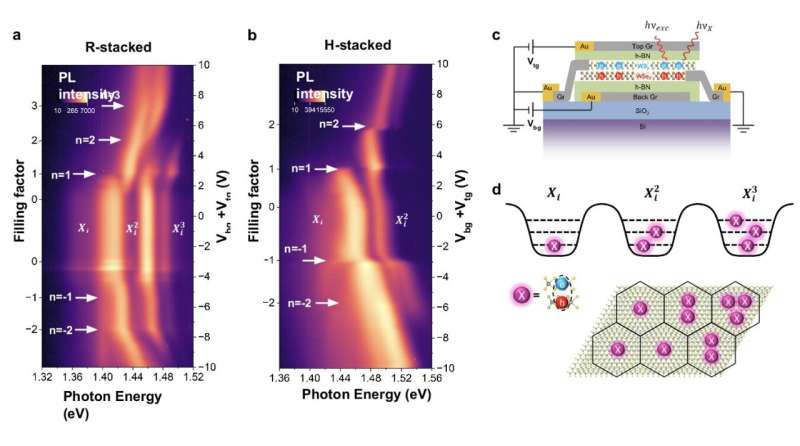November 27, 2023 feature
This article has been reviewed according to Science X's editorial process and policies. Editors have highlighted the following attributes while ensuring the content's credibility:
fact-checked
peer-reviewed publication
trusted source
proofread
The formation of an excitonic Mott insulator state in a moiré superlattice

When a negatively charged electron and a positively charged hole in a pair remain bound together following excitation by light, they produce states known as excitons. These states can influence the optical properties of materials, in turn enabling their use for developing various technologies.
A team of researchers at Rensselaer Polytechnic Institute, Imperial College London, University of California Riverside, Carnegie Mellon University, and other institutes worldwide have been studying the formation of excitons for years now, while also trying to identify new promising materials for optoelectronic applications.
In a paper, published in Nature Physics, they present evidence of a so-called excitonic Mott insulator state in a WSe2/WS2 based moiré superlattice (i.e., a periodic interference pattern arising from overlaying two atomic layers with a slightly different periodicity).
"In our previous work, we have shown that electron and electron correlation interaction is strong in this WSe2/WS2 moiré superlattice," Sufei Shi, one of the researchers who carried out the study, told Phys.org.
"We suspect that the exciton-electron and exciton-exciton interaction is also strong. We can potentially utilize this strong exciton correlation to realize new quantum states of excitons, which are bosons and would be different from fermions (electrons)."
Shi and his colleagues have been studying moiré superlattices for a while, due to their unique structure that makes them desirable for manipulating excitons. These structures are made up of two or more atomically thin crystals stacked on top of each other, but at a characteristically twisted angle producing what is known as "lattice mismatch."
In their previous research, the researchers showed that the interaction between electrons were particularly strong in a moiré superlattice based on WSe2 and WS2 crystals. In their new paper, they set out to further examine this same structure and explore its potential as a platform to realize quantum states of excitons.
"In our experiment, we mostly used optical spectroscopy techniques, particularly photoluminescence (PL) spectroscopy," Shi explained. "The emitted photon energy of interlayer exciton as a function of the doping (electrons or holes added to the moiré superlattice) and excitation power (controlling the average number of exciton density) reveals the strong electron-exciton repulsion and exciton-exciton repulsion."
The experiments carried out by Shi and his colleagues gathered evidence that an exciton-driven Mott insulator state emerges in the WSe2/WS2 structure, specifically when one interlayer exciton occupies a cell in a cell of the moiré superlattice. This state could have interesting implications for the study and development of quantum systems.
"The most notable achievement of our study is the formation of an excitonic Mott insulator state, which is a prediction of the bosonic Hubbard model," Shi said. "This shows that the exciton correlation is indeed strong in the moiré superlattice, and we can use that to construct quantum states arising from many-body Hamiltonian of bosons."
The recent study by this team of researchers further validates previous findings, highlighting the potential of this WS2/WSe2 moiré superlattice for studying and engineering new correlated states. The excitonic Mott insulator state it unveiled could be reproduced and further examined in future research, while also informing other works utilizing the same experimental platform.
"In our next studies, we want to explore the valley-spin, a new quantum degree of freedom, of this excitonic Mott insulator state," Shi added. "We also want to use our new understanding to construct new quantum state and perform quantum simulations based on excitons or exciton-electron mixture."
More information: Zhen Lian et al, Valley-polarized excitonic Mott insulator in WS2/WSe2 moiré superlattice, Nature Physics (2023). DOI: 10.1038/s41567-023-02266-2.
Journal information: Nature Physics
© 2023 Science X Network


















